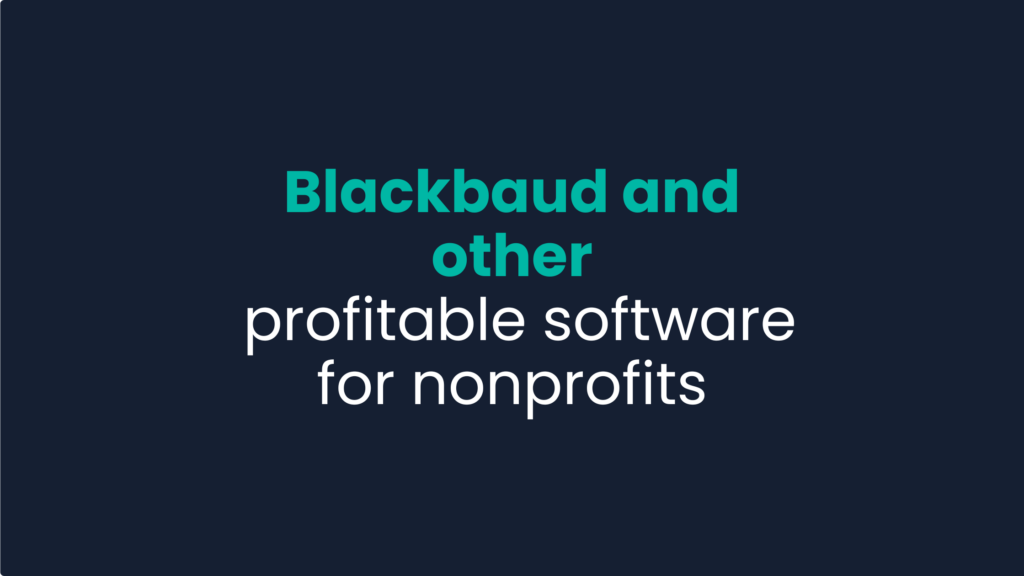Generally, when investors consider buying shares of a company, “not for profit” isn’t something that they gravitate towards. In the game of capitalism at least, the (eventual) goal of enterprises is to turn a profit for the shareholders. Certainly many companies attempt and succeed at also doing good in the world, but profit is how you keep score.
One might then conclude that investing in software companies that serve nonprofits would be a mistake. This would be a poor conclusion. Nonprofits, which can include anything from churches to foundations and everything in between, are buyers of software just like for-profit companies.
In this article, we focus on Blackbaud, the largest software provider for nonprofits (and a public company, so we have information to understand the business). We also delve into a few of their largest competitors and how the popularity of corporate social responsibility (CSR) programs have helped create a few large software companies specifically focused on those workflows.
Product and business
Blackbaud is a software provider focused on the nonprofit and education sectors, as well as companies involved in social responsibility. Their software supports all sorts of activities that these kinds of companies partake in, including fundraising, financial management, digital giving, grantmaking, and corporate social responsibility. Blackbaud was founded in 1981 and now operates in more than 100 countries, serving nearly 100,000 customers in 2023.
Blackbaud breaks their business up into two end markets: social and corporate, each with slightly different strategies and product features.
The first end market — social — is where they began their business. It includes nonprofits, educational institutions, houses of worship and healthcare organizations. The binding thread between them is that they have fundraising as a core component of their business. Blackbaud does a good job of explaining why fundraising (and these types of organizations) have specific needs that aren’t solved by horizontal software tools. Here’s a list of things they need to do, that Blackbaud’s tools help accomplish:
- Solicit funds and build relationships with major and institutional donors
- Garner small cash contributions from numerous contributors
- Manage and develop complex relationships with large numbers of constituents
- Communicate their accomplishments and the importance of their mission online and offline
- Comply with complex accounting, tax, and reporting requirements that differ from for-profit businesses
- Solicit cash and in-kind contributions from businesses to help raise money or deliver products and services
- Provide a wide array of programs and services to individual constituents and beneficiaries
- Improve data collection and information sharing capabilities for employees, volunteers, and donors by creating and providing distributed access to centralized databases
In their “corporate” segment, there are different challenges. For this segment (focused on companies, grantmaking institutions and foundations), here are the problems they face:
- Quantify and improve the impact of their grants
- Cultivate better relationships with grantees
- Achieve better internal collaboration and alignment with board members, reviewers, and other stakeholders
- Illustrate the impact of their corporate philanthropy and education efforts to the communities they serve
- Engage employees in meaningful volunteering, giving, and other activities
- Ensure that their philanthropic efforts align with their business initiatives
- Manage all of a foundation’s activities, including fundraising and accounting
- Expand the reach of their fundraising efforts
- Cultivate new and existing donors
As you might expect (because they started with it), the social sector business makes up the majority of their revenue.
Blackbaud’s product suite contains literally dozens of products for all sorts of end markets, but the theme is that they aim to solve these problems for their customers and solve them holistically. They are the oldest and largest software provider to the nonprofit end market and it shows.
Screenshot of just their most popular products
Summary of the types of products they sell
Financial highlights
Blackbaud has had slow revenue growth most years (mid single-digits). From 2017 to 2023, the total revenue CAGR was 5.8%. This aligns with the broader nonprofit software market growth, which is estimated between 5-8% (example). As a 43-year-old company that is the largest player in the space, it makes sense that they would track the broader market growth rate pretty closely. They had one outlier growth year (2022 at 14.1% growth), the difference of which can largely be attributed to additional revenue associated with the Jan 2022 $750m acquisition of EVERFI. For context, in 2023 Blackbaud had a total revenue of a little over $1.1B.
Blackbaud has increased recurring revenue as a percent of total revenue. From the very top line, Blackbaud splits their revenue between recurring revenue and one-time services revenue. According to their most recent 10-K, their services revenue is, “comprised of fees for one-time consulting (including creative services), analytic and onsite training services, and fees for retained and managed services contracts that we do not expect to have a term consistent with our cloud solution contracts.” In 2017, services revenue was a little over $100m in revenue (~13% of total revenue) and in 2023 it fell to about $34m (~3% of total revenue), while the recurring revenue grew.
This was certainly intentional as their recurring revenue segment is more valuable. Not only is the revenue more predictable (and thus requires less resources to get back to the same spot) but it’s also higher margin. Back in 2017, the services segment had an 18% gross margin, and it’s fallen to 8-10% these days (likely just viewed as a loss leader). Meanwhile, the core recurring revenue business has gross margins in the high 50s.
Recurring revenue is split between “contractual” (~70%) and “transactional” (~30%) recurring revenue. Contractual recurring revenue is traditional SaaS and content subscription revenue. Transactional revenue consists of mostly payment processing on donor transactions, tuition payments and consumer donations. They are growing at similar rates.
Gross margins have stayed steady in the mid to low 50s. If you follow software businesses closely, you’ll know that this is a pretty low gross margin for a software business. Most SaaS businesses have gross margins between 75-85% (with some achieving even higher). To explain the difference, we look to their “Cost of recurring revenue” line item. Some of the things it’s comprised of make sense for a software business: cost of customer support personnel, hosting costs, and amortization of software development expenses. Then there are a few that might explain the difference: third-party royalty and data expenses, and transaction-based costs related to payment processing. Their annual reports don’t go into detail, but both of these items can be high cost.
Blackbaud is ~breakeven on a net income basis, but has >30% adjusted EBITDA margins. The largest items between net income and EBITDA are depreciation & amortization and stock-based compensation. A more detailed breakdown can be found in their annual report. Given these EBITDA margins and growth rate, Blackbaud approaches the Rule of 40 most years.
Blackbaud spends money on M&A and is kickstarting a share buyback program. As with many companies that grow slowly but have strong cash flow, Blackbaud has grown through acquisitions (more about that in the next section). As they continue to spit off more cash, they also announced an updated share buyback program in July 2024, increasing the original amount of $500m to $800m.
Other significant players
Large, multiproduct software vendors like Salesforce, Oracle and Microsoft compete in most verticals, and nonprofits are no exception. Salesforce (maybe obviously) has CRM tools dedicated to nonprofits, though Blackbaud does integrate with them for more features. Oracle NetSuite has a landing page that shows off their products built for nonprofits, mostly for accounting and back office workflows. Microsoft has a lower-priced product that is certainly used by nonprofits, and they make it easy for them with grants and other programs.
Foundant Technologies provides cloud-based software for nonprofits, grantmakers, and scholarship providers. While they have fundraising tools, they focus more on the core operations of these entities, helping to manage processes like grant applications, scholarship programs, and fund accounting. For example, their grant software helps nonprofits create forms, manage & process applications, communicate with potential grantees and report / measure those activities. Foundant raised $150m from L Squared Partners in February 2023.
FrontStream is a digital fundraising software for nonprofits and socially responsible companies. Their platform seems to focus more on the long-tail of small donors, helping organizations manage auctions, peer-to-peer campaigns, and virtual events. Some examples of their tools include things like creating donation pages and managing the associated payments. FrontStream was purchased by Marlin Equity back in 2018. Marlin has over $8B in AUM and invests in primarily B2B software companies through a few different kinds of funds.
DonorPerfect is also a software solution tailored to nonprofits to help them with fundraising. Nonprofits might use DonorPerfect to create donation forms, automate workflows, and generate reports to measure donor engagement and fundraising success. They are owned by SofterWare, which is a bootstrapped company (seems to be one of the largest in the industry).
Benevity is a platform that helps corporations with their corporate social responsibility programs. They build software that aims to align corporate social goals with employee engagement in those programs. As an example, companies might use Benevity to set up corporate matching for donations or organize employee-driven volunteer events. Benevity has institutional backing from Hg Capital, TPG’s Rise Fund, Generation Investment Management and others.
WizeHive and Submittable merged as of August 2024, creating a leader in grant management software. This is increasingly important as foundations have become a larger portion of nonprofit funding (viewed as more reliable than individual donors, if nonprofits can access their grant programs). Submittable raised several rounds of VC funding and was originally a tool to help publishers manage manuscript submissions. They quickly pivoted to broader use cases, and these days are a corporate social platform that has tools for grant management, community investment, employee volunteering/giving, and other functions for corporations, government entities, and foundations. WizeHive, meanwhile, is also a grant management software tool and most recently took on growth capital from LLR Partners in 2021. Since the investment, they’ve purchased BrightFunds (employee giving/engagement) and WeHero (workplace volunteering platform), before eventually buying Submittable. This is an active acquirer in the corporate social responsibility space and likely a company of significant scale these days.
There are also several vertical solutions such as Ministry Brands and Tithely (churches), or GiveCampus and AffinaQuest (higher education) that help primarily with various forms of fundraising for those markets. There are also players like Tyler Technologies, which is an acquisitive public company known for their government software but also has solutions for education and might compete with some of the companies listed above.

